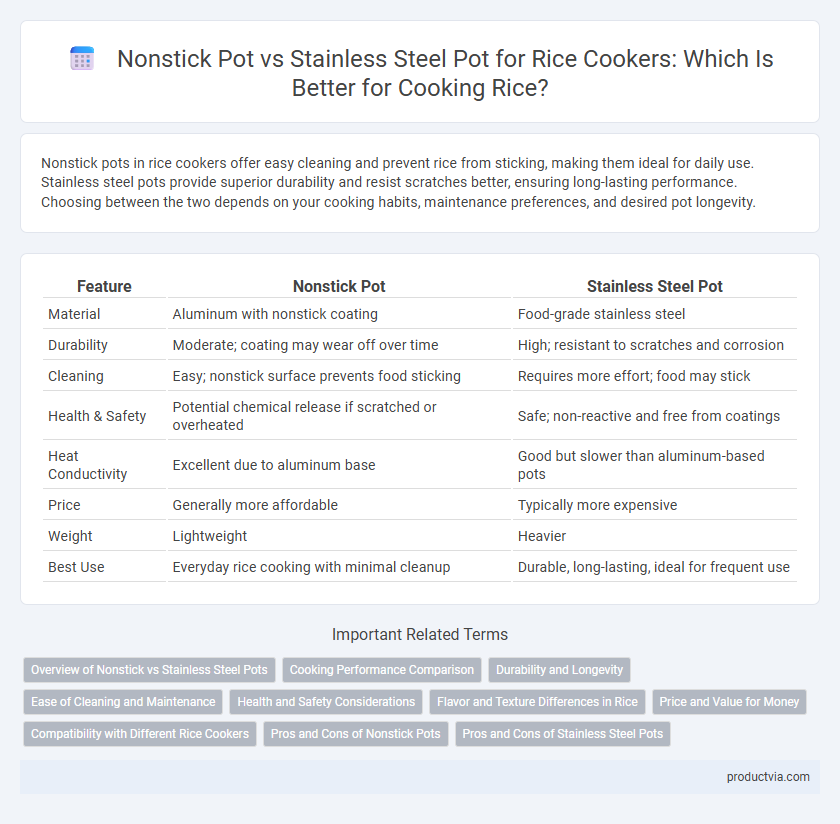Nonstick pots in rice cookers offer easy cleaning and prevent rice from sticking, making them ideal for daily use. Stainless steel pots provide superior durability and resist scratches better, ensuring long-lasting performance. Choosing between the two depends on your cooking habits, maintenance preferences, and desired pot longevity.
Table of Comparison
| Feature | Nonstick Pot | Stainless Steel Pot |
|---|---|---|
| Material | Aluminum with nonstick coating | Food-grade stainless steel |
| Durability | Moderate; coating may wear off over time | High; resistant to scratches and corrosion |
| Cleaning | Easy; nonstick surface prevents food sticking | Requires more effort; food may stick |
| Health & Safety | Potential chemical release if scratched or overheated | Safe; non-reactive and free from coatings |
| Heat Conductivity | Excellent due to aluminum base | Good but slower than aluminum-based pots |
| Price | Generally more affordable | Typically more expensive |
| Weight | Lightweight | Heavier |
| Best Use | Everyday rice cooking with minimal cleanup | Durable, long-lasting, ideal for frequent use |
Overview of Nonstick vs Stainless Steel Pots
Nonstick pots in rice cookers offer easy food release and straightforward cleaning, making them ideal for sticky rice varieties. Stainless steel pots provide superior durability and resist scratching or peeling, suitable for long-term use and higher cooking temperatures. Choosing between nonstick and stainless steel depends on priorities like convenience, maintenance, and cooking style preferences.
Cooking Performance Comparison
Nonstick pots in rice cookers offer superior food release and easier cleaning, preventing rice from sticking and burning during cooking. Stainless steel pots provide even heat distribution and durability but may require more attention to prevent rice from sticking or scorching. Choosing between the two depends on priorities for maintenance ease versus long-term durability and heat conduction efficiency.
Durability and Longevity
Nonstick pots in rice cookers offer easy cleaning and prevent rice from sticking but tend to wear out faster due to coating scratches and heat degradation. Stainless steel pots provide superior durability and longevity, resisting dents, scratches, and high temperatures without degrading over time. Choosing stainless steel enhances the rice cooker's lifespan, making it a more reliable long-term investment despite requiring more careful cleaning.
Ease of Cleaning and Maintenance
Nonstick pots in rice cookers offer superior ease of cleaning due to their smooth, coated surfaces that prevent rice from sticking and burning, significantly reducing scrubbing time and effort. Stainless steel pots, while more durable and resistant to scratches, often require more thorough cleaning to remove food residue and may need special care to maintain their shine and prevent discoloration. For hassle-free maintenance, nonstick pots are generally preferred, but users should avoid metal utensils to preserve the coating's integrity and extend its lifespan.
Health and Safety Considerations
Nonstick pots in rice cookers offer easy cleaning and prevent rice from sticking, but they may release harmful chemicals if overheated or scratched, raising health concerns. Stainless steel pots provide a safer cooking surface free from chemical coatings, minimizing risks of toxicity and ensuring durability for long-term use. Choosing stainless steel enhances safety by avoiding potential nonstick toxin exposure while maintaining excellent heat distribution.
Flavor and Texture Differences in Rice
Nonstick pots in rice cookers create fluffier, softer rice by preventing sticking and allowing more even heat distribution, which enhances the delicate texture of each grain. Stainless steel pots retain more natural flavors due to their non-porous surface, but may cause slight sticking, resulting in a slightly firmer, chewier texture that some prefer for dishes like fried rice. Choosing between nonstick and stainless steel pots influences the rice's final mouthfeel and taste profile, aligning with individual cooking preferences and meal types.
Price and Value for Money
Nonstick pots for rice cookers generally offer a lower upfront price and easier cleaning, providing excellent value for budget-conscious consumers. Stainless steel pots tend to be more expensive but offer superior durability and long-term cost efficiency due to their resistance to scratches and corrosion. Choosing between the two depends on whether immediate affordability or extended lifespan and maintenance savings hold more value.
Compatibility with Different Rice Cookers
Nonstick pots offer excellent compatibility with most modern rice cookers due to their lightweight design and even heat distribution, enhancing cooking efficiency. Stainless steel pots, while compatible with a wide range of rice cookers, are better suited for models with powerful heating elements to ensure uniform cooking. Choosing between nonstick and stainless steel pots depends on the rice cooker's heating method and user preference for ease of cleaning or durability.
Pros and Cons of Nonstick Pots
Nonstick pots in rice cookers offer easy cleaning and prevent rice from sticking, making cooking and maintenance convenient. They require gentle utensils to avoid scratching and typically have a shorter lifespan due to coating wear compared to stainless steel pots. While nonstick pots heat evenly, their durability and safety may decline over time with frequent use and high temperatures.
Pros and Cons of Stainless Steel Pots
Stainless steel pots for rice cookers offer excellent durability and resistance to scratches, dents, and corrosion, making them ideal for long-term use. They provide even heat distribution and are dishwasher safe, but their lack of nonstick coating can cause rice to stick and make cleaning more challenging. While stainless steel pots are preferred for health safety and high-temperature cooking, they often require more oil and careful monitoring to prevent scorching.
Nonstick Pot vs Stainless Steel Pot for rice cookers Infographic

 productvia.com
productvia.com